Western Sydney University - 401207 Jordan Case Study Analysis
VerifiedAdded on 2022/09/14
|6
|1551
|12
Case Study
AI Summary
This case study analyzes Jordan's experience with Crohn's disease, exploring the structural and functional changes leading to weight loss, the pain pathway and the effect of morphine, and the clinical manifestations indicating a deterioration of the condition. The analysis also covers the characteristics and rationale behind the use of intravenous fluids, specifically Hartman's solution, in managing Jordan's fluid balance. The assignment highlights the impact of Crohn's disease on the gastrointestinal tract, the challenges in managing chronic pain, and the importance of fluid replacement in patients experiencing dehydration due to the disease. The study also delves into the causes and consequences of perianal abscesses, bowel obstruction, and the overall impact on the patient's health, offering insights into diagnosis, treatment, and patient care.

Jordan Case Study
Student’s Name
University
Student’s Name
University
Paraphrase This Document
Need a fresh take? Get an instant paraphrase of this document with our AI Paraphraser
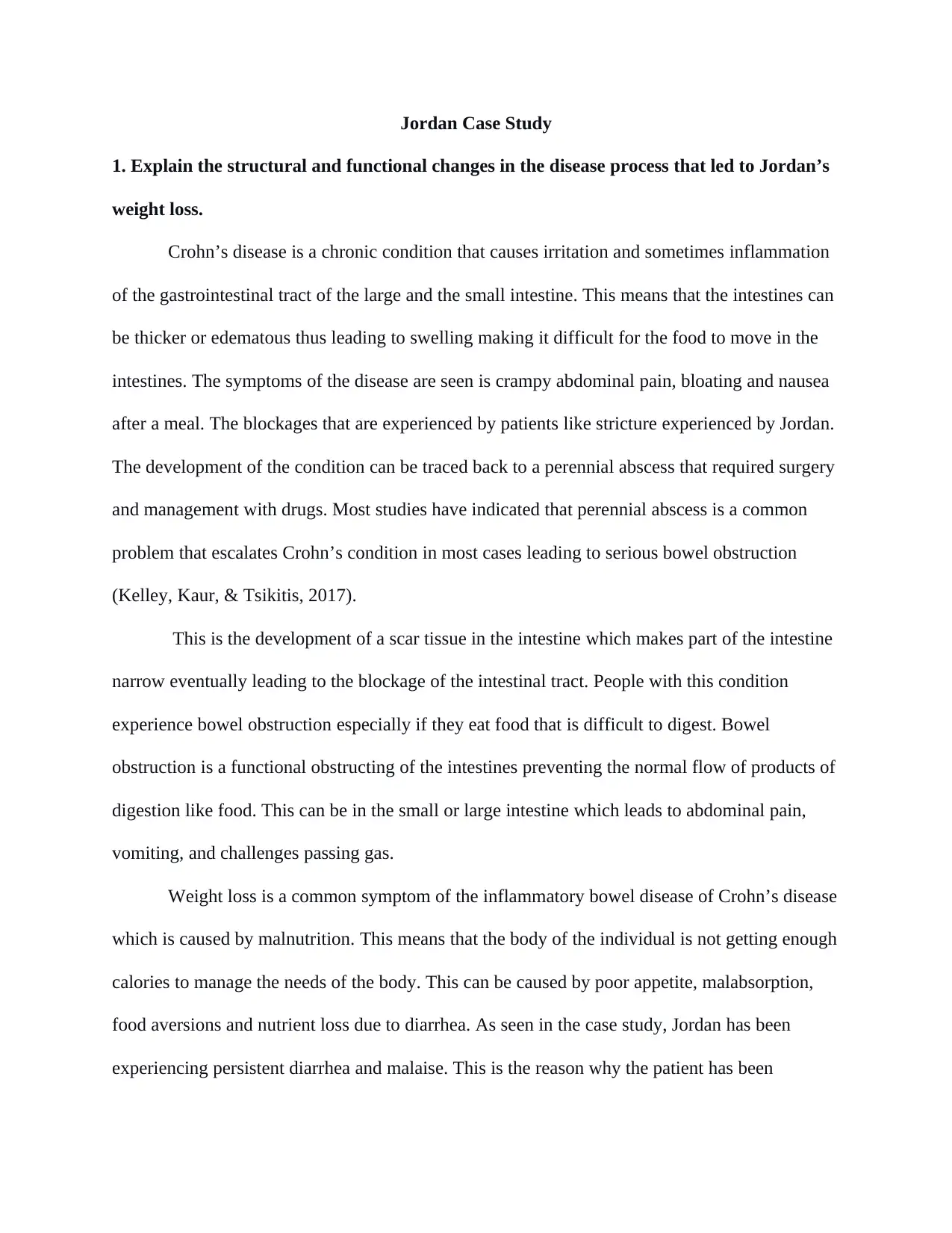
Jordan Case Study
1. Explain the structural and functional changes in the disease process that led to Jordan’s
weight loss.
Crohn’s disease is a chronic condition that causes irritation and sometimes inflammation
of the gastrointestinal tract of the large and the small intestine. This means that the intestines can
be thicker or edematous thus leading to swelling making it difficult for the food to move in the
intestines. The symptoms of the disease are seen is crampy abdominal pain, bloating and nausea
after a meal. The blockages that are experienced by patients like stricture experienced by Jordan.
The development of the condition can be traced back to a perennial abscess that required surgery
and management with drugs. Most studies have indicated that perennial abscess is a common
problem that escalates Crohn’s condition in most cases leading to serious bowel obstruction
(Kelley, Kaur, & Tsikitis, 2017).
This is the development of a scar tissue in the intestine which makes part of the intestine
narrow eventually leading to the blockage of the intestinal tract. People with this condition
experience bowel obstruction especially if they eat food that is difficult to digest. Bowel
obstruction is a functional obstructing of the intestines preventing the normal flow of products of
digestion like food. This can be in the small or large intestine which leads to abdominal pain,
vomiting, and challenges passing gas.
Weight loss is a common symptom of the inflammatory bowel disease of Crohn’s disease
which is caused by malnutrition. This means that the body of the individual is not getting enough
calories to manage the needs of the body. This can be caused by poor appetite, malabsorption,
food aversions and nutrient loss due to diarrhea. As seen in the case study, Jordan has been
experiencing persistent diarrhea and malaise. This is the reason why the patient has been
1. Explain the structural and functional changes in the disease process that led to Jordan’s
weight loss.
Crohn’s disease is a chronic condition that causes irritation and sometimes inflammation
of the gastrointestinal tract of the large and the small intestine. This means that the intestines can
be thicker or edematous thus leading to swelling making it difficult for the food to move in the
intestines. The symptoms of the disease are seen is crampy abdominal pain, bloating and nausea
after a meal. The blockages that are experienced by patients like stricture experienced by Jordan.
The development of the condition can be traced back to a perennial abscess that required surgery
and management with drugs. Most studies have indicated that perennial abscess is a common
problem that escalates Crohn’s condition in most cases leading to serious bowel obstruction
(Kelley, Kaur, & Tsikitis, 2017).
This is the development of a scar tissue in the intestine which makes part of the intestine
narrow eventually leading to the blockage of the intestinal tract. People with this condition
experience bowel obstruction especially if they eat food that is difficult to digest. Bowel
obstruction is a functional obstructing of the intestines preventing the normal flow of products of
digestion like food. This can be in the small or large intestine which leads to abdominal pain,
vomiting, and challenges passing gas.
Weight loss is a common symptom of the inflammatory bowel disease of Crohn’s disease
which is caused by malnutrition. This means that the body of the individual is not getting enough
calories to manage the needs of the body. This can be caused by poor appetite, malabsorption,
food aversions and nutrient loss due to diarrhea. As seen in the case study, Jordan has been
experiencing persistent diarrhea and malaise. This is the reason why the patient has been
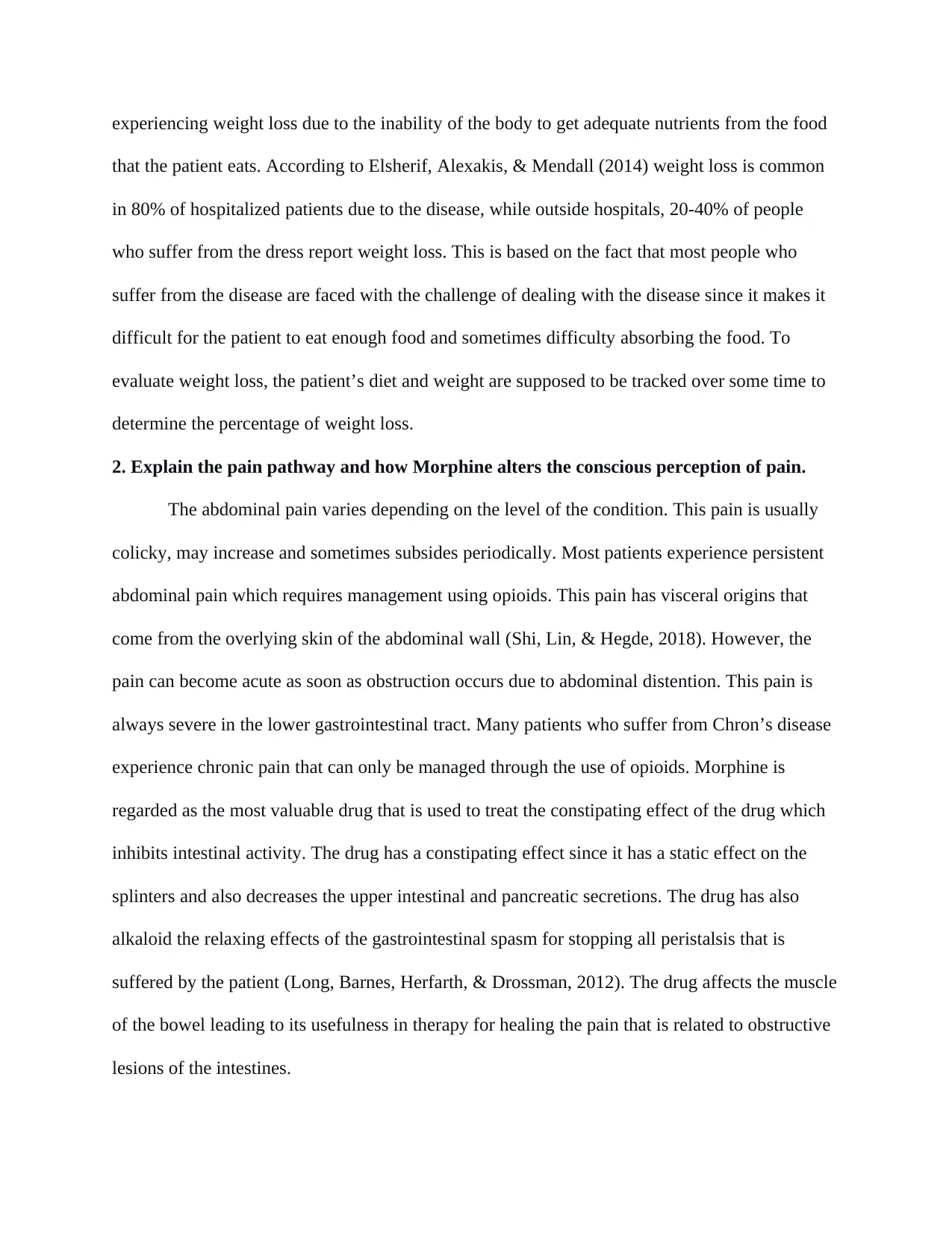
experiencing weight loss due to the inability of the body to get adequate nutrients from the food
that the patient eats. According to Elsherif, Alexakis, & Mendall (2014) weight loss is common
in 80% of hospitalized patients due to the disease, while outside hospitals, 20-40% of people
who suffer from the dress report weight loss. This is based on the fact that most people who
suffer from the disease are faced with the challenge of dealing with the disease since it makes it
difficult for the patient to eat enough food and sometimes difficulty absorbing the food. To
evaluate weight loss, the patient’s diet and weight are supposed to be tracked over some time to
determine the percentage of weight loss.
2. Explain the pain pathway and how Morphine alters the conscious perception of pain.
The abdominal pain varies depending on the level of the condition. This pain is usually
colicky, may increase and sometimes subsides periodically. Most patients experience persistent
abdominal pain which requires management using opioids. This pain has visceral origins that
come from the overlying skin of the abdominal wall (Shi, Lin, & Hegde, 2018). However, the
pain can become acute as soon as obstruction occurs due to abdominal distention. This pain is
always severe in the lower gastrointestinal tract. Many patients who suffer from Chron’s disease
experience chronic pain that can only be managed through the use of opioids. Morphine is
regarded as the most valuable drug that is used to treat the constipating effect of the drug which
inhibits intestinal activity. The drug has a constipating effect since it has a static effect on the
splinters and also decreases the upper intestinal and pancreatic secretions. The drug has also
alkaloid the relaxing effects of the gastrointestinal spasm for stopping all peristalsis that is
suffered by the patient (Long, Barnes, Herfarth, & Drossman, 2012). The drug affects the muscle
of the bowel leading to its usefulness in therapy for healing the pain that is related to obstructive
lesions of the intestines.
that the patient eats. According to Elsherif, Alexakis, & Mendall (2014) weight loss is common
in 80% of hospitalized patients due to the disease, while outside hospitals, 20-40% of people
who suffer from the dress report weight loss. This is based on the fact that most people who
suffer from the disease are faced with the challenge of dealing with the disease since it makes it
difficult for the patient to eat enough food and sometimes difficulty absorbing the food. To
evaluate weight loss, the patient’s diet and weight are supposed to be tracked over some time to
determine the percentage of weight loss.
2. Explain the pain pathway and how Morphine alters the conscious perception of pain.
The abdominal pain varies depending on the level of the condition. This pain is usually
colicky, may increase and sometimes subsides periodically. Most patients experience persistent
abdominal pain which requires management using opioids. This pain has visceral origins that
come from the overlying skin of the abdominal wall (Shi, Lin, & Hegde, 2018). However, the
pain can become acute as soon as obstruction occurs due to abdominal distention. This pain is
always severe in the lower gastrointestinal tract. Many patients who suffer from Chron’s disease
experience chronic pain that can only be managed through the use of opioids. Morphine is
regarded as the most valuable drug that is used to treat the constipating effect of the drug which
inhibits intestinal activity. The drug has a constipating effect since it has a static effect on the
splinters and also decreases the upper intestinal and pancreatic secretions. The drug has also
alkaloid the relaxing effects of the gastrointestinal spasm for stopping all peristalsis that is
suffered by the patient (Long, Barnes, Herfarth, & Drossman, 2012). The drug affects the muscle
of the bowel leading to its usefulness in therapy for healing the pain that is related to obstructive
lesions of the intestines.
⊘ This is a preview!⊘
Do you want full access?
Subscribe today to unlock all pages.

Trusted by 1+ million students worldwide
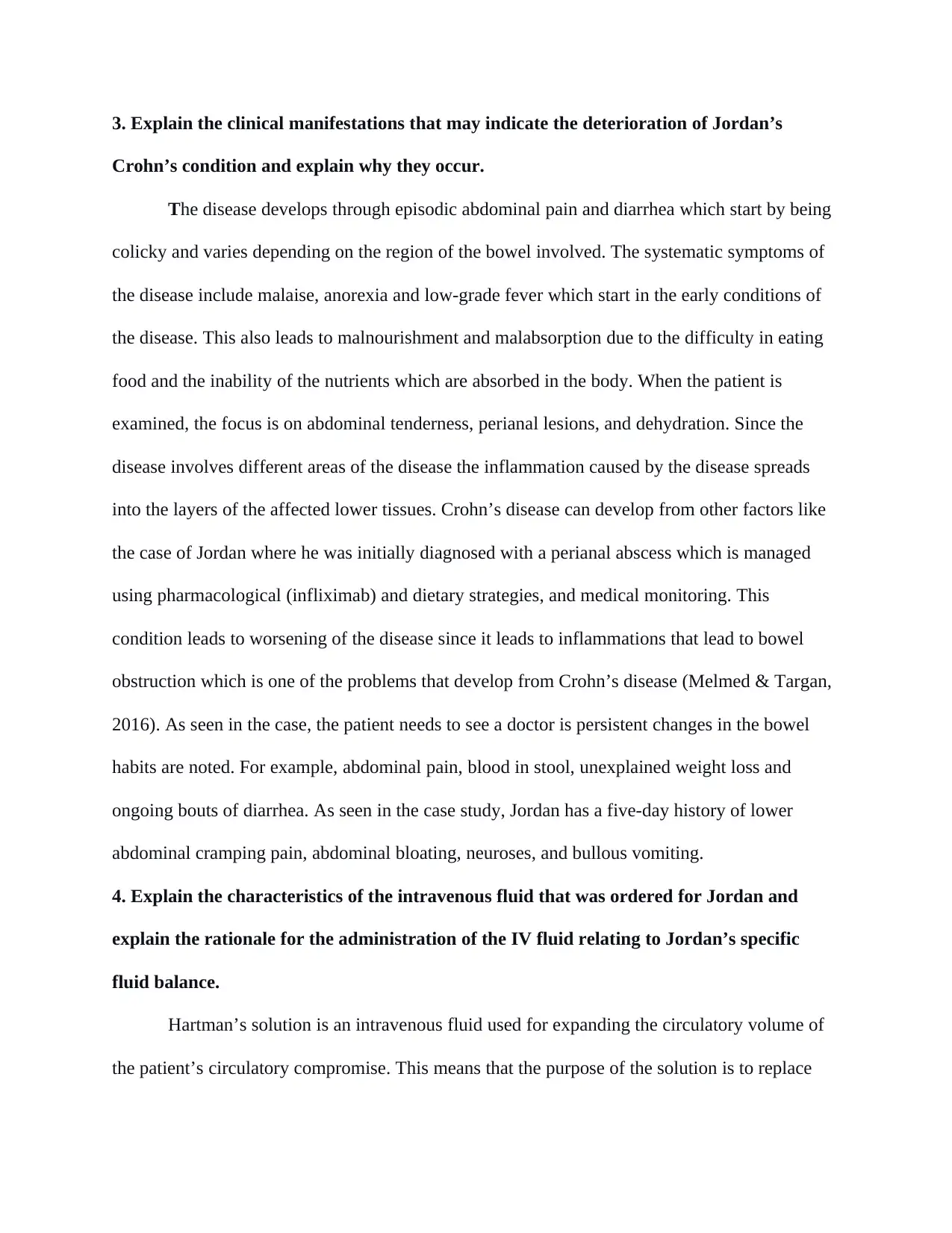
3. Explain the clinical manifestations that may indicate the deterioration of Jordan’s
Crohn’s condition and explain why they occur.
The disease develops through episodic abdominal pain and diarrhea which start by being
colicky and varies depending on the region of the bowel involved. The systematic symptoms of
the disease include malaise, anorexia and low-grade fever which start in the early conditions of
the disease. This also leads to malnourishment and malabsorption due to the difficulty in eating
food and the inability of the nutrients which are absorbed in the body. When the patient is
examined, the focus is on abdominal tenderness, perianal lesions, and dehydration. Since the
disease involves different areas of the disease the inflammation caused by the disease spreads
into the layers of the affected lower tissues. Crohn’s disease can develop from other factors like
the case of Jordan where he was initially diagnosed with a perianal abscess which is managed
using pharmacological (infliximab) and dietary strategies, and medical monitoring. This
condition leads to worsening of the disease since it leads to inflammations that lead to bowel
obstruction which is one of the problems that develop from Crohn’s disease (Melmed & Targan,
2016). As seen in the case, the patient needs to see a doctor is persistent changes in the bowel
habits are noted. For example, abdominal pain, blood in stool, unexplained weight loss and
ongoing bouts of diarrhea. As seen in the case study, Jordan has a five-day history of lower
abdominal cramping pain, abdominal bloating, neuroses, and bullous vomiting.
4. Explain the characteristics of the intravenous fluid that was ordered for Jordan and
explain the rationale for the administration of the IV fluid relating to Jordan’s specific
fluid balance.
Hartman’s solution is an intravenous fluid used for expanding the circulatory volume of
the patient’s circulatory compromise. This means that the purpose of the solution is to replace
Crohn’s condition and explain why they occur.
The disease develops through episodic abdominal pain and diarrhea which start by being
colicky and varies depending on the region of the bowel involved. The systematic symptoms of
the disease include malaise, anorexia and low-grade fever which start in the early conditions of
the disease. This also leads to malnourishment and malabsorption due to the difficulty in eating
food and the inability of the nutrients which are absorbed in the body. When the patient is
examined, the focus is on abdominal tenderness, perianal lesions, and dehydration. Since the
disease involves different areas of the disease the inflammation caused by the disease spreads
into the layers of the affected lower tissues. Crohn’s disease can develop from other factors like
the case of Jordan where he was initially diagnosed with a perianal abscess which is managed
using pharmacological (infliximab) and dietary strategies, and medical monitoring. This
condition leads to worsening of the disease since it leads to inflammations that lead to bowel
obstruction which is one of the problems that develop from Crohn’s disease (Melmed & Targan,
2016). As seen in the case, the patient needs to see a doctor is persistent changes in the bowel
habits are noted. For example, abdominal pain, blood in stool, unexplained weight loss and
ongoing bouts of diarrhea. As seen in the case study, Jordan has a five-day history of lower
abdominal cramping pain, abdominal bloating, neuroses, and bullous vomiting.
4. Explain the characteristics of the intravenous fluid that was ordered for Jordan and
explain the rationale for the administration of the IV fluid relating to Jordan’s specific
fluid balance.
Hartman’s solution is an intravenous fluid used for expanding the circulatory volume of
the patient’s circulatory compromise. This means that the purpose of the solution is to replace
Paraphrase This Document
Need a fresh take? Get an instant paraphrase of this document with our AI Paraphraser
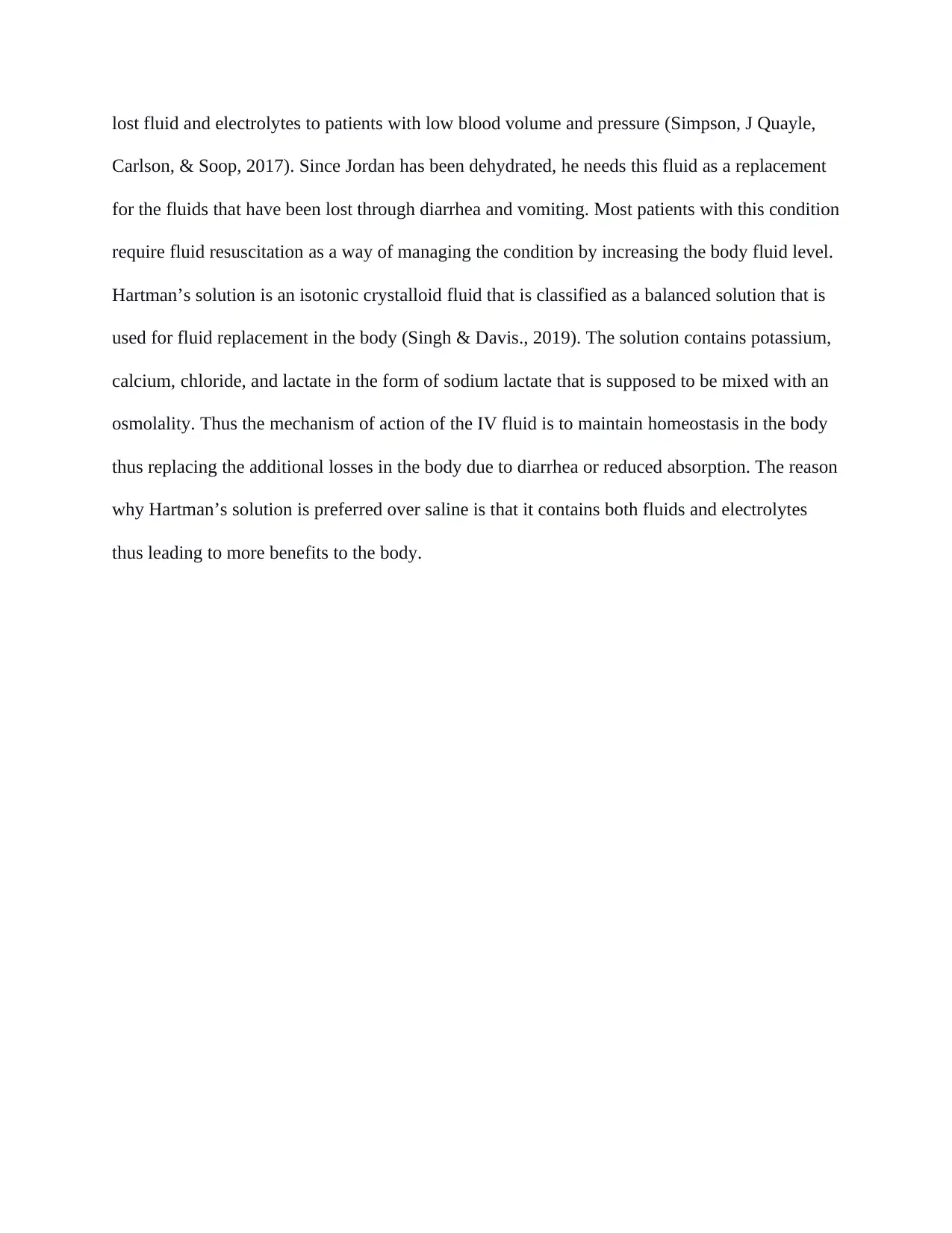
lost fluid and electrolytes to patients with low blood volume and pressure (Simpson, J Quayle,
Carlson, & Soop, 2017). Since Jordan has been dehydrated, he needs this fluid as a replacement
for the fluids that have been lost through diarrhea and vomiting. Most patients with this condition
require fluid resuscitation as a way of managing the condition by increasing the body fluid level.
Hartman’s solution is an isotonic crystalloid fluid that is classified as a balanced solution that is
used for fluid replacement in the body (Singh & Davis., 2019). The solution contains potassium,
calcium, chloride, and lactate in the form of sodium lactate that is supposed to be mixed with an
osmolality. Thus the mechanism of action of the IV fluid is to maintain homeostasis in the body
thus replacing the additional losses in the body due to diarrhea or reduced absorption. The reason
why Hartman’s solution is preferred over saline is that it contains both fluids and electrolytes
thus leading to more benefits to the body.
Carlson, & Soop, 2017). Since Jordan has been dehydrated, he needs this fluid as a replacement
for the fluids that have been lost through diarrhea and vomiting. Most patients with this condition
require fluid resuscitation as a way of managing the condition by increasing the body fluid level.
Hartman’s solution is an isotonic crystalloid fluid that is classified as a balanced solution that is
used for fluid replacement in the body (Singh & Davis., 2019). The solution contains potassium,
calcium, chloride, and lactate in the form of sodium lactate that is supposed to be mixed with an
osmolality. Thus the mechanism of action of the IV fluid is to maintain homeostasis in the body
thus replacing the additional losses in the body due to diarrhea or reduced absorption. The reason
why Hartman’s solution is preferred over saline is that it contains both fluids and electrolytes
thus leading to more benefits to the body.
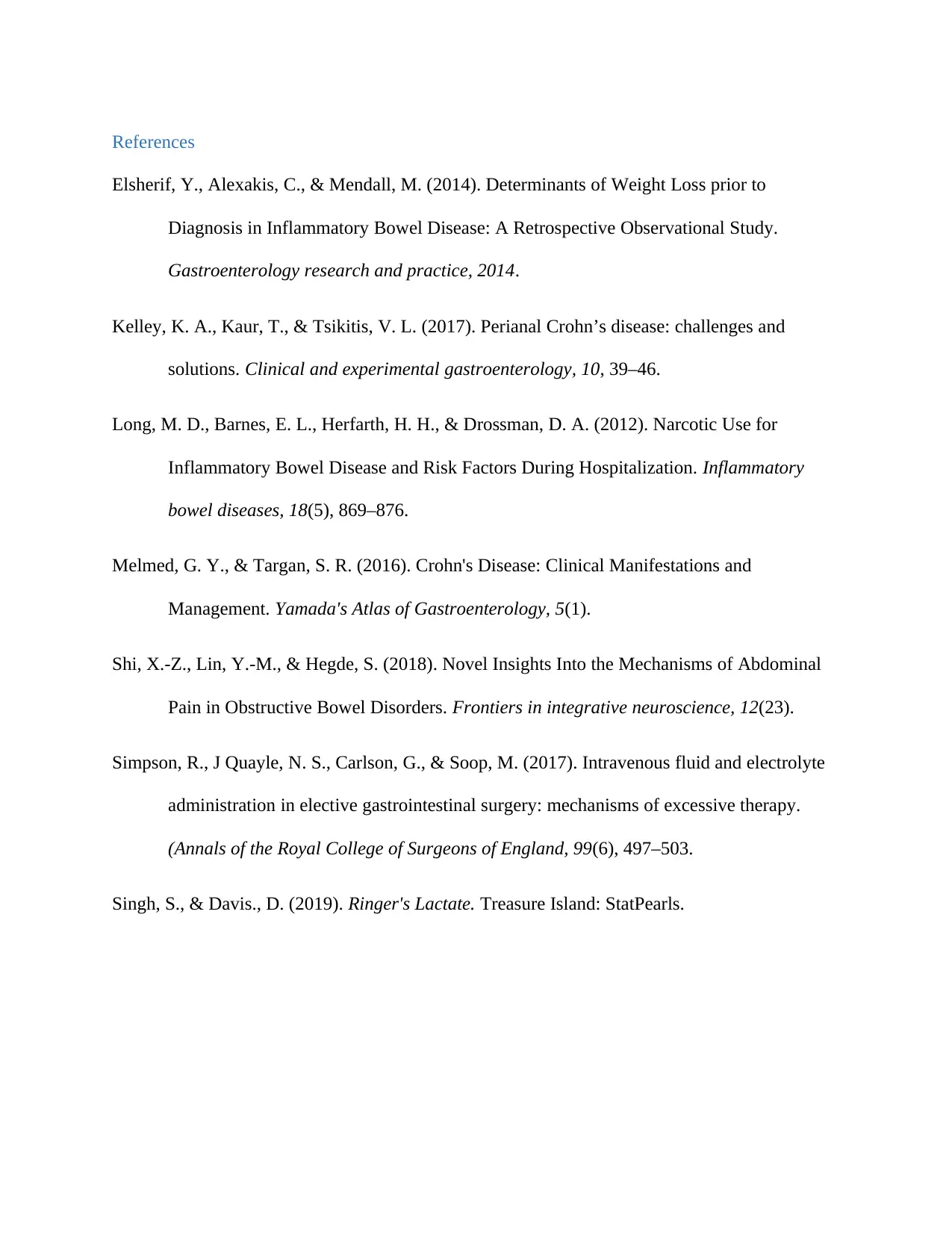
References
Elsherif, Y., Alexakis, C., & Mendall, M. (2014). Determinants of Weight Loss prior to
Diagnosis in Inflammatory Bowel Disease: A Retrospective Observational Study.
Gastroenterology research and practice, 2014.
Kelley, K. A., Kaur, T., & Tsikitis, V. L. (2017). Perianal Crohn’s disease: challenges and
solutions. Clinical and experimental gastroenterology, 10, 39–46.
Long, M. D., Barnes, E. L., Herfarth, H. H., & Drossman, D. A. (2012). Narcotic Use for
Inflammatory Bowel Disease and Risk Factors During Hospitalization. Inflammatory
bowel diseases, 18(5), 869–876.
Melmed, G. Y., & Targan, S. R. (2016). Crohn's Disease: Clinical Manifestations and
Management. Yamada's Atlas of Gastroenterology, 5(1).
Shi, X.-Z., Lin, Y.-M., & Hegde, S. (2018). Novel Insights Into the Mechanisms of Abdominal
Pain in Obstructive Bowel Disorders. Frontiers in integrative neuroscience, 12(23).
Simpson, R., J Quayle, N. S., Carlson, G., & Soop, M. (2017). Intravenous fluid and electrolyte
administration in elective gastrointestinal surgery: mechanisms of excessive therapy.
(Annals of the Royal College of Surgeons of England, 99(6), 497–503.
Singh, S., & Davis., D. (2019). Ringer's Lactate. Treasure Island: StatPearls.
Elsherif, Y., Alexakis, C., & Mendall, M. (2014). Determinants of Weight Loss prior to
Diagnosis in Inflammatory Bowel Disease: A Retrospective Observational Study.
Gastroenterology research and practice, 2014.
Kelley, K. A., Kaur, T., & Tsikitis, V. L. (2017). Perianal Crohn’s disease: challenges and
solutions. Clinical and experimental gastroenterology, 10, 39–46.
Long, M. D., Barnes, E. L., Herfarth, H. H., & Drossman, D. A. (2012). Narcotic Use for
Inflammatory Bowel Disease and Risk Factors During Hospitalization. Inflammatory
bowel diseases, 18(5), 869–876.
Melmed, G. Y., & Targan, S. R. (2016). Crohn's Disease: Clinical Manifestations and
Management. Yamada's Atlas of Gastroenterology, 5(1).
Shi, X.-Z., Lin, Y.-M., & Hegde, S. (2018). Novel Insights Into the Mechanisms of Abdominal
Pain in Obstructive Bowel Disorders. Frontiers in integrative neuroscience, 12(23).
Simpson, R., J Quayle, N. S., Carlson, G., & Soop, M. (2017). Intravenous fluid and electrolyte
administration in elective gastrointestinal surgery: mechanisms of excessive therapy.
(Annals of the Royal College of Surgeons of England, 99(6), 497–503.
Singh, S., & Davis., D. (2019). Ringer's Lactate. Treasure Island: StatPearls.
⊘ This is a preview!⊘
Do you want full access?
Subscribe today to unlock all pages.

Trusted by 1+ million students worldwide
1 out of 6
Related Documents
Your All-in-One AI-Powered Toolkit for Academic Success.
+13062052269
info@desklib.com
Available 24*7 on WhatsApp / Email
![[object Object]](/_next/static/media/star-bottom.7253800d.svg)
Unlock your academic potential
Copyright © 2020–2025 A2Z Services. All Rights Reserved. Developed and managed by ZUCOL.





